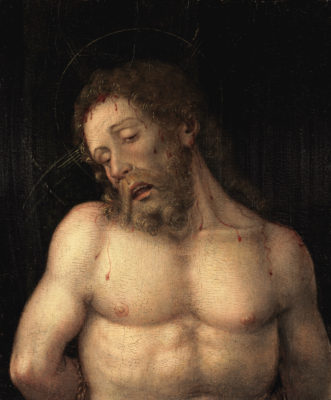Christ at the column.
Circa 1490-1495.
Tempera and oil on panel.
55,4 x 45,2 cm (21 13/16 x 17 13/16 in.).
Bibliography:
. W. Arslan, Contributi alla storia della pittura veronese. 2. Due inediti di Liberale, in “Bollettino della Società Letteraria di Verona”, 1933, pp. 5-7.
. G. Fossi, in La Fondazione Roberto Longhi a Firenze, Milan, 1980, pp. 252-253.
. A. De Marchi, a.v. Liberale da Verona, in La Pittura in Italia. Il Quattrocento, Milan, 1987, pp. 664-665.
. M. Gregori, in Gothic to Renaissance. European Painting 1300-1600, catalogue of the exhibition, Colnaghi, London-New York, 1988/89, n° 9.
. D. Scrase, London, Colnaghi, From Gothic to Renaissance, in “The Burlington Magazine”, CXXX, n° 1029, December 1988, p. 942 and fig. 73.
. Auf Goldenem Grund, exhibition catalogue under the direction of J. Kräftner, Liechtenstein Museum, Vienna, 2008, pp. 78-79, n°40.
Exhibition:
. Colnaghi, Gothic to Renaissance. European Painting 1300-1600, London, 26th October – 12th November 1988 ; New York, 23rd November 1988 – 28th January 1989, n° 9.
. Vienna, Liechtenstein Museum, Auf Goldenem Grund, 12th Dec. 2008-14th April 2009, cat. 40.
The Christ figure is tied to the column that is behind Him in the shadows, but around which the coiled ropes are well visible. This tormented image is touched by a strong expressionism, which is depicted in the twist of the head, the muscular power of the torso, the lowered eyes and the half-open mouth showing two rows of teeth. A certain overall distortion indicates exhaustion and an indescribable suffering, underlined by the tears and by the thin streaks of blood that flow from the forehead and the neck.
Of note is the draughtsmanship of the painter who finely details the locks of hair and the beard, the wrinkles, the nipples, the rope and the tears that fall from the eyelids and roll down the cheeks to the sides of the nose. Over and above the Mantegnesque models of which Liberale was certainly aware, one should see here the influence of painters from the north of Italy, where he travelled, and more specifically that of Antonello da Messina and Giovanni Bellini. Liberale probably also knew of Martin Schongauer’s engravings which began to circulate in Italy during the last decade of the century.
Contrasting with this descriptive talent, the very sprightly sketch of the halo and the rendering of the muscular masses with powerful chiaroscuro build the dramatic and visionary style of this painter who “knew how to make his figures cry” as Vasari wrote. As late as in the 18th century a painter like Gian Bettino Cignaroli marvelled at Liberale’s shadows :
“[…]in Liberale’s paintings one recognizes […] a depth that derives from the daring and well-placed shadows the equivalent of which it would be difficult to find in the same period. He has managed to express the passions of the soul with an extreme skill, for which Vasari has so often congratulated him […]”
This Christ at the column evidently comes after the artist’s long stay in Tuscany, from 1466 to 1476, his journey to Venice where the archives tell us that he stayed in 1487 and his return to Verona in 1489. The two other versions of the same subject, the one from the Musée du Petit Palais in Avignon (43 x 36 cm (1615/16 x 143/16 in.) (fig.1 ), that shows a younger, thinner Christ, without a beard and harder in style and the one from the Roberto Longhi collection (fig. 2), that is similar to the one from the Musée du Petit Palais, but less expressive and cut down on several sides (one can only see the beginnings of the arms ; the eyes are nearly closed) also date from the end of the ninth decade of the 15th century. This is the time of the Pietà in the Alte Pinakothek of Munich (fig. 3), one of Liberale’s masterpieces, where the artist paints in a softened and sensual way a scene of great expressivity and with a very original composition. One can particularly notice the similarity between our Christ’s curls of hair, eyes and eyebrows and those of the right hand angel in the Munich Pietà and the very precise description of Christ’s nipples in both pictures. As Mina Gregori pointed out, the marked facial features are also characteristic of Liberale’s maturity, as can be seen with the angels and prophets in the signed frescoes from the Bonaveri Chapel in Sant’Anastasia (Verona), which date from 1491/92, and even more particularly in the magnificent Descent from the Cross that is in the same chapel, in a lunette.
The range of colours is that of the post-1470 period, date around which he abandoned the bright hues of Veronese painters in favour of more pastel tones that better matched the poetry he wanted to express. In the warmer flesh colours transpire the physical suffering of the man, still very alive.
